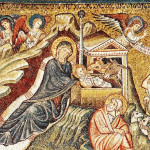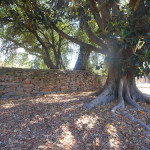We run our website the way we wished the whole internet worked: we provide high quality original content with no ads. We are funded solely by your direct support. Please consider supporting this project.
Is there Archeological Support for the Reliability of the Gospels?
One of the many tests historians typically submit documents to in accessing their historical reliability concerns the extent to which archeology supports or undermines the historic claims the document makes. So we need to investigate the extent to which archeology confirms, or refutes, aspects of the Gospels. Before we address this question, however, a preliminary word is in order.
Contrary to much popular opinion, archeology does not usually give us “the hard facts.” Rather, the meaning and implications of most archeological artifacts is usually ambiguous and thus open to a variety of interpretations. This ambiguity has often been ignored, or at least minimized, by both Christian apologists and liberal New Testament critics. Some on both sides have consequently tended to overstate their cases, one side arguing that archeology “proves” the New Testament to be true while the other side argues it “proves” it to be full of historical errors. The reality is that archeology proves very little – if by “proof” one means something like, “making a case that no reasonable person can deny.”
Against this extremism, I (and Paul Eddy, with whom I’ve collaborated in doing my research and writing on New Testament issues) adopt a minimalistic approach to archeological findings. While I believe there are a significant amount of archeological discoveries that at least indirectly support the New Testament, I also don’t want to place very much weight on this evidence. The strongest case for or against the historicity of the Gospels is made on other grounds. Nevertheless, archeology is hardly irrelevant.
With this in mind I’ll briefly review the twelve archeological discoveries I think are most significant in shedding light on the general historical reliability of the Gospels.
Evidence of the Nature of First Century Judaism
Those who argue that the Jesus of the Gospels is largely fictional usually argue that the Jews of the first century were thoroughly “Hellenized” (that is, they had come to think much like their pagan Greco-Roman neighbors.) For if the Jews had remained orthodox in their beliefs and practices, it’s hard if not impossible to imagine them believing (let alone creating!) a pagan-like legend about a divine man. In other words, if the Jews of the first century were orthodox in their beliefs and practices, it’s much harder to dismiss as legends the early Jewish-Christian reports of Jesus found in the Gospels. Since Christianity arose out of Palestinian Judaism, the evidence that is most relevant to assessing the historicity of the Gospels centers on Palestine. And it just so happens that the evidence indicates that Palestinian Judaism was very orthodox at the time of Christ. Some of the evidence suggesting this is the following:
* Coins minted by Herod in first century Galilee avoided human representations, suggesting that Jews remained sensitive to traditional Jewish interpretations of the second commandment against having graven images.
* Material used for ceramic wares in areas heavily populated by Jews consistently conforms to Levitical laws.
* Ritual bathing pools have been discovered throughout the region, suggesting that Jews generally held fast to traditional purity codes.
* A conspicuous absence of pork bones in Jewish populated areas at this time suggests that Jews adhered to traditional dietary codes
* Burial sites in Palestine reflect traditional Jewish practices.
In my opinion, discoveries such as these provide rather compelling grounds for rejecting the claim of some legendary-Jesus theorists that first century Palestinian Jews were Hellenized to the point where they could have generated and/or accepted a legend about a miracle working God-man.
Bethsaida
Recent excavations of Bethsaida confirm that the Gospel depiction of this city as a fishing village existing on the north shore of the sea of Galilee is accurate. Also, a jar with a cross was discovered at Bethsaida in 1994 and dates sometime before 67 AD, confirming the witness of Paul and the Gospels, as well as Tacitus and Josephus, that a movement centered on a crucified messiah was flourishing at this time.
A Galilean Fishing Boat
In 1986, a sunken fishing boat that dates from the first century was found in the Sea of Galilee. Measuring 8.2 x 2.3 meters, Galilean archaeologist Jonathan Reed has noted that “[i]t could certainly hold thirteen people,” the number of people necessary for Jesus and his twelve disciples to cross the Sea as mentioned a number of times in the Gospels (e.g. Mk 4:36-37). Not only this, but the boat’s rather shallow draft (1.2 meters) comports well with Mark’s report that, in the midst of a storm, the boat began to founder as it filled with water (Mk 4:37). The boat thus arguably provides confirmation of two aspects of the early Jesus tradition.
The “Pilate Stone”
In 1962, a first century Latin inscription of the Roman prefect Pontius Pilate dedicating a temple to Tiberius was discovered at Caesarea Maritima, confirming that Pilate reigned in the position ascribed to him by the Gospels. Moreover, by confirming that he was prefect, the “Pilate stone,” as it has been called, confirms that Pilate would have had the authority to condemn and pardon, as the Gospel accounts report.
A Crucified Man
The entombed remains of a first century crucified man in Palestine were discovered in 1968. The find confirms aspects of the biblical account of Jesus’ crucifixion, including the practice of breaking the legs of crucified criminals (Jn 19: 32-33). It also conclusively refutes the argument – yet espoused by Dominic Crossan – that victims of crucifixion couldn’t be granted a proper burial in a private family tomb, as the Gospels claim of Jesus (Mk 15:42-47).
The Caiaphas Ossuary
In 1990, an ossuary was discovered in a burial cave south of Jerusalem’s Old City. The limestone ossuary was uncharacteristically ornate, signaling ownership by a wealthy family. Etched rather crudely into its side in Aramaic was the name “Caiaphas.” A good number of experts in the field agree that we here have the first recovered remains of a person mentioned in the New Testament, and he happens to be the high priest who, according to the Gospels, presided over the Jewish trial of Jesus.
The Pool of Siloam
In John’s Gospel, Jesus is reported to have healed a blind man by spitting on the ground, mixing up some mud and rubbing this mud on his eyes. He then commanded the man to wash his eyes “in the pool of Siloam” (9:1-7). Archeologists in the early 20th century discovered a 5th century Byzantine church constructed on a site that people of the time thought was the pool of Siloam, but scholars doubted that this site was the location of the pool of Siloam referred to in John. Indeed, liberal scholars often argued that the pool referred to in John’s Gospel was mythic.
In 2004, however, workers repairing a broken sewage pipe just east of the city of David happened to uncover two ancient steps that, once excavated, turned out to lead down into a massive pool that is now conclusively identified as the pool of Siloam. Coins embedded in the plaster of the steps allowed them prove the pool was in existence during the time of Jesus.
Peter’s House
In Capernaum, a simple first century house was discovered beneath a fourth-century church that itself was buried beneath a fifth-century church. Clearly, Christians in the early centuries of church history knew there was something very significant about this first century house. On the walls of one of the rooms of the first century house are inscribed a variety of Christian invocations, most written in the second century, that mention Peter. What is more, the walls and floors of the first century house are plastered, something that was rare for homes in this era, but common for places where larger groups gathered. It plausibly suggests this was a house that had been converted into a house church where Christians gathered. On this basis, a number of reputable scholars, ranging across the conservative-liberal spectrum, argue this is likely the house of the apostle Peter, the very place Jesus used as a base of operations for his ministry (Mk 1:29-35; 2:1; Mt 4:13;8:14-16 ).
Jesus’ Burial Site
Some reputable scholars, including, most significantly, James Charlesworth, argue that we have reasonable grounds for accepting that Jesus was buried in a tomb now underneath the Church of the Holy Sepulchre. Though the identification of this site as the place where Jesus was crucified goes back to the fourth century, it was routinely dismissed by modern scholars primarily because it appeared to lie inside the city walls where Jewish burials would have been forbidden. However, more recent archeological evidence suggests that in the 30s AD this site would not have have been within the city walls. For this and several other reasons, an increasing number of scholars are suggesting it is more probable than not that this traditional Church represents the site where Jesus was buried.
Lysanias, tetrarch of Abilene
Many scholars used to assume that Luke was mistaken when he identified Lysanias as the tetrarch of Abilene around 27 A.D (Lk 3:1), for it had earlier been confirmed by archeology that King Lysanias had been ruler over Chalcis a half century earlier. However, two Greek inscriptions have now revealed the existence of “Lysanias the tetrach” who reigned in Abilene during the time of Tiberius (A.D. 14-37), thus confirming the accuracy of Luke’s designation.
I might here add that in his Gospel and in Acts, Luke mentions a number of titles of officials and local customs that have been confirmed by archeology. What makes this fact all the more impressive is that these titles changed frequently. Were Luke and his sources not as reliable as they seem to have been, we would have expected him to have gotten these titles wrong a good percentage of the time. (See Is the Book of Acts Reliable?)
Quirinius, proconsul of Syria
Related to this, for a long while scholars have questioned the accuracy of Luke’s account of the census under the reign of Quirinius (Lk 2:2, cf. Ac 5:37). The reason for this skepticism is that the ancient evidence suggests that Quirinius was not governor of Syria until AD 6. The problem, of course, is that Jesus was born at least ten to twelve years before this time. Hence many scholars have concluded that Luke simply got his facts wrong.
There is a plausible way of resolving this apparent discrepancy even apart from archeology. Though Luke 2:2 is usually translated something like, “This was the first (protos) census that took place while Quirinius was governor,” it’s possible to translate protos not as “first” but as “before.” So it’s possible Luke is saying that the census that led Joseph and Mary to Bethlehem took place before the census taken under Quirinius in 6 BC – the better known one that caused an uprising. But archeology now offers a better way of squaring Luke with the historical evidence.. A coin has been discovered that mentions a Quirinius who was proconsul of Syria and Cilicia from 11 BC until after 4 BC, thus reigning at the time of Jesus’ birth, as Luke says. It may be, therefore, that the same man ruled twice, or that there were two rulers with this same name.
The James Ossuary
The last archeological discovery I want to discuss neither supports nor denies the historicity of the Gospels, but it’s worth mentioning because it’s so recent and so interesting. In 2002, a first century ossuary was discovered with the words, “James, son of Joseph, brother of Jesus,” etched on it. Within a short time, the ossuary was being countenanced as “the first archaeological link to Jesus and his family.” It’s of course possible the Joseph, James and Jesus mentioned in inscription refer to first century people with these names who are different from those mentioned in the New Testament, but it’s extremely unlikely. Among other things, brothers of the deceased were only mentioned on ossuaries when they were very well-known. So one has to wonder how probable it is that there was more than one man named James who was the son of a Joseph who had a well-known brother named Jesus during the rather short interval of time in pre-70 A.D when ossuaries were used in Palestine.
It was a truly remarkable find. Initially the authenticity of the discovery was almost uniformly supported by archeological and paleographical experts. Unfortunately, subsequent inspections have called these original assessments into question. It seems everyone agrees the ossuary itself goes back to the first century, but there’s now some suspicion that the inscription is a later forgery. The fact that the world’s best experts in the field are deeply divided over their assessments has led some to suspect that factors other than an objective assessment of evidence may be influencing the players in this debate. In any event, given the polemics surrounding this finding, no firm conclusions can be drawn about it.
Summary
As we mentioned, archeology can rarely prove whether a document is historically reliable or not. At the same time, when we consider the archeological evidence reviewed in this essay alongside all the other reasons we have for concluding that the Gospels are generally reliable, I would argue that these findings provide circumstantial support for the Gospels. They provide us with yet one more reason to conclude that it is more probable than not that the Gospels are generally reliable, and thus that their portrait of Jesus is substantially rooted in history, not legend.
Notes
(1) Both Greg Boyd and Paul Eddy are behind this response. For a much fuller discussion of this question, see P. Eddy and G. Boyd, The Jesus Legend (Baker, 2007). and G. Boyd and P. Eddy, Lord or Legend? (Baker, 2007)
(2) For brief summaries of the excavations of Bethsaida and Khirbet Cana see J. H. Charlesworth, “Jesus Research and Near Eastern Archaeology: Reflections on Recent Developments,” in Neotestamentica et Philonica: Studies in Honor of Peder Borgen, ed. D. E. Aune, T. Seland, and J. H. Ultrichsen (Boston: Brill, 2003), 55-57.
Category: Essays
Tags: Apologetics, Essay, Gospels, Jesus, New Testament
Topics: Biblical Reliability
Related Reading

The Cross in the Manger
There has been a strand within the Western theological tradition—one that is especially prevalent in contemporary American Evangelicalism—that construes the significance of the cross in strictly soteriological terms. The cross is central, in this view, but only in the sense that the reason Jesus came to earth was to pay the price for our sin…

Why Did Jesus Curse the Fig Tree?
One of the strangest episodes recorded in the Gospels is Jesus cursing a fig tree because he was hungry and it didn’t have any figs (Mk 11:12-14; Mt 21:18-19). It’s the only destructive miracle found in the New Testament. What’s particularly puzzling is that Mark tells us the reason the fig tree had no figs…

Podcast: Could Jesus Have Sinned? (part one)
Greg considers the nature of temptation and the temptability of God. http://traffic.libsyn.com/askgregboyd/Episode_0114.mp3

William Wilberforce and the Possibility of “Christian” Politics
William Wilberforce was a passionate Christian who entered politics for the sole purpose of ending the slave trade. For more than thirty years he passionately and courageous labored to get Parliament to outlaw the practice. His life’s dream was fulfilled a month before he died in 1833. It’s no surprise, therefore, that Wilberforce is frequently…

Terror in the Night
I’ll never forget the night it first happened to me. I was thirteen, sharing a bedroom with my older brother. I woke up in the middle of the night and felt as if something was pinning me to the bed, choking me, and electrocuting me, all at the same time. The wind was blowing through…

What Does a Perfect God Look Like?
The “classical view of God” refers to the view of God that has dominated Christian theology since the earliest Church fathers. According to this theology, God is completely “immutable.” This means that God’s being and experience never changes in any respect. God is therefore pure actuality (actus purus), having no potentiality whatsoever, for potentiality is…
